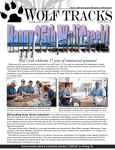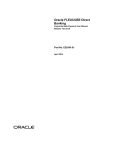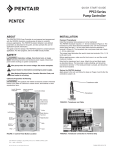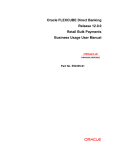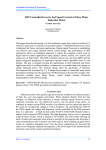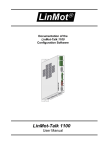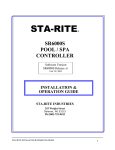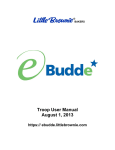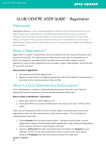Download SubjectSignups Experimenter`s User Manual
Transcript
TM SubjectSignups the original web-based sign-up system Experimenter’s User Manual SubjectSignups™ and this document Copyright © 1999-2074 James W. Corpening II. All Rights Reserved. Table of Contents Table of Contents ............................................................................................................................................ i Publication History......................................................................................................................................... ii Release History.............................................................................................................................................. iii Original Foreword ......................................................................................................................................... iv New Foreword................................................................................................................................................ v Introduction .................................................................................................................................................... 1 Tour of SubjectSignups................................................................................................................................... 2 Participant Pages ........................................................................................................................................ 2 Experimenter Pages .................................................................................................................................... 7 Appendix Table of Figures...................................................................................................................... 13 Date of Publication: 15 Jan 2009 i Publication History 24 Sep 1999 09 Dec 1999 09 Jan 2000 15 Mar 2000 15 Feb 2006 15 Jan 2009 Initial publication. Updated page appearance changes. Minor modifications to explanations of tasks. Updated the experimenter navigation header to include the Recover a Lost Experiment hyperlink, and included a brief description of such in the Tour. Updated the participant navigation header to include the Search link, and included a brief description of such in the Tour. Brought the remainder of the manual up to date. New version to reflect the new, PHP & MySQL version of SubjSign. Date of Publication: 15 Jan 2009 ii Release History 16 August 1999 v1.00.990816 Initial release. 10 January 2000 v1.50.000110 Several cosmetic changes. Changed the required subdirectory structure. Changed the user manuals, as described in the Publication History section of each manual. Removed the need for redundant radio buttons on the View Experiments and Edit Experiments pages. Dynamic appointment dates on the View Experiments page. A date now disappears when there are no more times available for that date. Fixed a flaw that deleted all identical appointment times when the first time was claimed. Fixed a flaw that prevented correct update of instructor logs when a participant had two appointments for the same experiment. Appointment times are now made available upon cancellation if the corresponding date exists in the data file. Lengthened experiment description and participant specification fields on the Add New Experiment page. Changed the instructor logs to keep each participant's information on a single line (formerly, it was one line per experiment--multiple lines per participant). Added an Auto-Select All Sign-ups option on the Experiment Sign-ups page. Removed the View Your Credits link in the experimenter navigation frame. Configurable max dates and max times, applicable to all experiments. Added an Import Participant ID Numbers page, to be used in conjunction with the Restrict Logins to Known Participants checkbox on the Configuration page. Please see the description of that option. Added a Restrict Logins to Known Participants checkbox on the Configuration page, to be used in conjunction with the Import Participant ID Numbers page. These two options allow you to establish the list of potential participants before the semester begins, and thereafter restrict access to only those students. Increased the number of initial instructor fields in the Create and Modify Instructor List page--20 fields initially, five extra fields on each subsequent submission. 15 March 2000 v1.60.000315 Changed the Change Administrator ID Number task; now old admin number is not carried over from first page, and old number must be successfully entered as part of the change. Changed the storage format of #users.dat. Added a date check upon experiment addition, edit, cancellation, and sign-up. For cancellation, dates on or after experiment dates are not allowed. For other tasks, dates prior to today will not be allowed. Fixed a flaw regarding the use of spaces in dates and times, and the resultant storage problem. Added the Recover a Lost Experiment option—the ability to recover experiment files lost due to uncompleted edits. Fixed a flaw that wrote an extra data line in ExptNum.part files. Updated the Import Credits task; now writes an entry in the #users.dat and Instructor.part files, and requires that instructor be selected at submission. Import files must now be instructor-specific. Fixed a flaw that prevented assignment of negative credits from the Sign-up list page. Added a randomizer to experiments as presented on the View Experiments page. Added a better time sorter for the Sign-up list page. 03 March 2006 v2.00.060303 Miscellaneous adjustments. 15 January 2009 v. 3.00.090115 New version of SubjectSignups, now written in PHP and MySQL database (cf. Perl with flat-file). No frames; different Admin layout. Designed to be hosted by jwc, not an individual school. Ability to handle multiple schools with one interface. Added a couple more Admin options. Date of Publication: 15 Jan 2009 iii Original Foreword With the rapid expansion of the world-wide web (WWW), many types of transactions currently take place on line. These transactions include retail purchases, banking, and securities trading, so it is not surprising that even educational institutions offer on-line services. Now educational institutions—specifically, psychology departments—can use the web as an avenue for logging and tracking participant sign-ups in human research programs. SubjectSignups offers a convenient answer to managing research participation via the world-wide web. This manual provides an overview of SubjectSignups from an experimenter’s or participant’s perspective, and is intended to be read by experimenters. There is no need for a manual explaining participants’ use of SubjectSignups, and participants should not have access to these manuals. Some information on experimenters’ use of SubjectSignups is reserved by the administrator, and experimenters should contact their administrator for that necessary information. Information for administrators of SubjectSignups, including technical information on data storage and file management, may be found elsewhere, in the SubjectSignups Administrator’s Manual and Technical Reference. There is no reason that SubjectSignups should not continue to mature. Consequently, small portions of this manual may be inconsistent with the actual SubjectSignups. If they exist, these inconsistencies do not represent a lack of attention to documentation; rather, they simply represent a lag time between implementation of new functions and the public documentation of those functions. You may be assured that this manual was current as of the date of publication, and that new functions will soon be documented. If you find inconsistencies that need attention, or wish to contact me for any other reason, you may do so at the addresses below. I thank you for trying SubjectSignups, and I hope all works well for you. -James Corpening 24 September 1999 380 Taunton Place, upper Buffalo, NY 14216-1926 [email protected] Date of Publication: 15 Jan 2009 iv New Foreword The world-wide web, or just “the web,” has certainly expanded, even if its maturity is still in question. Nevertheless, the web is a very convenient medium in which to manage many types of transctions, including participant sign-ups in human research programs. To that end, SubjectSignups offers a convenient, web-based answer to managing research participation in research programs. As did its predecessor, this manual provides an overview of SubjectSignups, but there are some notable differences in the program. SubjectSignups has been rewritten in the scripting language PHP, using a MySQL database, whereas earlier versions were written in Perl, using a flat-file database system. Furthermore, SubjectSignups is designed to be hosted remotely, not on a college’s or university’s server, although that is still an option. There is no need for a manual explaining participants’ use of SubjectSignups, and participants should not have access to these manuals. Please do not print this manual, and be cautious about with whom you share it. If you find inconsistencies between SubjectSignups and this manual, or wish to contact me for any other reason, you may do so at the addresses below. I thank you for using SubjectSignups, and I hope all works well for you. Remember, though, that adequate testing of any software is essential before it is put into production. I welcome your suggestions for improvement. I acknowledge that use of the term subject to refer to human participants is considered by many, if not most, to be inappropriate and out of date. For that reason, this manual has been updated to reflect this contemporary attitude. I have chosen to keep the name of the product the same, however, so as not to introduce confusion in the minds of users. -James Corpening 15 January 2009 428 W. Delavan Ave. Buffalo, NY 14213-1413 [email protected] Date of Publication: 15 Jan 2009 v Introduction SubjectSignups is a web-based manager of human participant pool sign-ups and data, designed to be used by psychology departments that support human research and rely on participation by students. This version of SubjectSignups is written in the scripting language PHP for use on a web server, and it uses a MySQL database to hold and manage data. There are three types of log-ins available: Participant, Experimenter, and Administrator. Participants can view experiments and available appointment times, make appointments, cancel appointments, and view their sign-ups. Experimenters can do what participants can do (except viewing credits), but have further privileges to create, edit, and delete experiments, view sign-ups for a given experiment, and assign credit for participation. Administrators can do several administrative tasks, such as configure the system, e-mail credit reports, etc. The traditional system for participant pool sign-ups involves paper-based announcement of new experiments, often posted in one departmental location, and participant sign-ups from that same location. Experience reveals that the annoying problems with paper-based sign-ups include • students crowding the department halls registering for participation in experiments • students not tracking their own sign-ups and participation credits • students not notifying experimenters to cancel participation • experimenters and coordinators manually logging data Some of the advantages of SubjectSignups are • remote sign-ups (may be done from home or campus computer labs) • sign-ups and credits are logged and viewable by students and experimenters • e-mail notification of sign-ups and cancellations • digital record of student sign-up and participation • central collection of a semester’s data SubjectSignups makes use of cookies during its operation. Cookies have a bad reputation, and deservedly so. People who write cookies into their web pages often push the cookies onto a user’s hard drive and set an expiration date ten years in the future. Most of the sites that do this, however, do not need to write cookies to your computer. SubjectSignups uses temporary cookies that are not written to a user’s hard drive, but expire when the user’s browser is closed. If a user’s browser does not support, or a user declines, cookies, SubjectSignups will not work correctly. As of the date of this manual, browsers that successfully work with SubjectSignups are Mozilla Firefox (1.0 or higher), Internet Explorer (3.0 or higher), and Opera (3.21 or higher). Date of Publication: 15 Jan 2009 1 Tour of SubjectSignups Following is a graphical tour of the SubjectSignups pages. Each figure displays one of the SubjectSignups pages, and is followed by a description of the actions associated with that page. Although present throughout all interactions (except log-in pages), the navigation headers are displayed here in only the first figure of each of the Participant and Experimenter sections of The Tour. All options available to participants are available to experimenters (except viewing credits). The terms administrator and coordinator are used somewhat interchangably. Participant Pages Figure 1. Participant Log-in page. The Log-in page (Figure 1) is the page from which participants, experimenters, and administrators log into SubjectSignups. There are different log-in pages for participants, experimenters, and administrators, but the pages are almost identical to each other. From the experimenter log-in page, log-in identification numbers are checked against the list of approved identification numbers, as set by the administrator. Date of Publication: 15 Jan 2009 2 Figure 2. List Experiments page. The List Experiments page (Figure 2) is the first page to load upon leaving either the participant or the experimenter log-in page, and is also loaded when participants or experimenters select the List Experiments hyperlink in the navigation header. It is here that participants see what experiments are available, the list of which is presented in random order each time the page is loaded. Summary information is provided for keyword searches (via the browser’s Find command). Experiment dates listed on this page change as participants register for (and exhaust) available appointment times, and as experimenters update (or create) experiment information. Participants must select the More button next to the desired experiment to reach the Experiment Signup page, where they can see detailed information about the desired experiment. Date of Publication: 15 Jan 2009 3 Figure 3. Experiment Sign-up page. The Experiment Sign-up page (Figure 3) is the page at which participants see detailed information about the selected experiment, and choose the desired date and time of participation. After entering the required information (instructor list is established by the administrator), selecting the desired date and time, and selecting the Sign Up button, participants are asked to confirm their selection (page not shown). After confirming their selection, participants receive confirmation of their registration (page not shown) and sign-up information is e-mailed to the experiment contact and to the participant. This page is not directly accessible from any navigation header; rather, this page loads from the List Experiments page. Date of Publication: 15 Jan 2009 4 Figure 4. Search page. Figure 4 displays the Search page. From this page participants can search for experiments by month, date, and/or hour. Once they select at least one criterion and then select the Search button, participants will receive a Search Results page (not shown). From the Search Results page, participants can click the Sign Up button that corresponds to a given experiment to go directly to that Experiment Sign-Up page. Date of Publication: 15 Jan 2009 5 Figure 5. Your Appointments page. Figure 5 displays the Your Appointments page, which where participants can see the appointments for which they are presently registered, see the number of credits assigned them by experimenters, and cancel appointments. The appointments listed here include those appointments that participants have satisfied or cancelled, as well as those that they have yet to satisfy. After selecting an appointment and selecting the Submit Cancel button, participants are asked to confirm their cancellation. (page not shown). After confirming their cancellation, participants receive confirmation of the cancellation (page not shown), cancellation information is e-mailed to the experiment contact, and the relinquished date and time are made available for others. Cancellations are not allowed less than one day before the experiment. Date of Publication: 15 Jan 2009 6 Experimenter Pages Experimenters, please take note: DO NOT compromise your experiment sign-ups, or the sign-up system as a whole, by leaving your web browser open to use by another individual. Also, please allow only those individuals directly accountable for experiments to serve as experimenters (e.g., do not assign a onesemester undergraduate assistant the role of experimenter). Some security can be maintained by simple common sense, so please use it. The List Experiments page and the Search page are not described in this section; rather, they are described, above, in the Participant Pages section. Figure 6. Edit an Experiment page. Figure 6 displays the Edit an Experiment page (including the experimenter navigation header. This page is almost identical to the View Experiments page (described in the Participant Pages section), but allows the experimenter to edit the selected experiment’s information. Once in edit mode, the experimenter edits information in the same page in which one would create a new experiment. After editing information and selecting the Submit button in the editing page, updated experiment information is saved, and notice of the modification is e-mailed to the experiment contact and to the administrator. Experimenters Important Notes: Experiments (but not sign-ups) are removed from SubjectSignups when experimenters edit experiments. Experimenters must, therefore, submit the experiment information even if they make no changes. If, however, an experiment is lost due to an incomplete edit, it can be recovered in the Recover a Lost Experiment page. Date of Publication: 15 Jan 2009 7 Figure 7. Add a New Experiment page. The Add a New Experiment page (Figure 7 is just that--the page in which to add a new experiment. After entering the required information and selecting the Submit button, the new experiment is added to SubjectSignups, and notice is e-mailed to the experiment contact as well as to the participant pool coordinator. The experiment will not be available on the List Experiments page, though, until the administrator enables it. The numbers of date and time slots (below Participant Specifications) are configured by the administrator. This page is the same as the page in which experimenters edit existing experiment information. Date of Publication: 15 Jan 2009 8 Figure 8. View Sign-ups page. Figure 8 displays the View Sign-ups page, which the page from which experimenters see the present signups for any experiment. This page is also the first step in assigning positive or negative credits to participants, thus removing them from the sign-ups list. After selecting a View button, experimenters are presented with the Sign-ups page (see Figure 10). Experimenters can automatically select all sign-ups on the Sign-ups page by selecting the Select all sign-ups checkbox on this page. Date of Publication: 15 Jan 2009 9 Figure 9. Sign-up List page. The Sign-up List page (Figure 10) is the page in which experimenters view currently scheduled participants, and assign credit (e.g., 2) or no credit (i.e., 0). Negative credits must be assigned by an administrator. After either modifying or accepting the number of credits reported at the top of the page, and selecting the Credit checkbox next to participants, an experimenter submits the task and receives confirmation of the credited participants. If the experimenter changes the default number of credits to a negative number, the selected participants will lose that number of credits. This page is not directly accessible from any navigation header; rather, this page loads from the View Sign-ups page. Note that an experimenter will assign the same number of credits to all individuals selected; assigning both negative and positive credits to different individuals requires two submissions. As of the date of this manual, errors in assigning credits can only be corrected via the administrator pages. Date of Publication: 15 Jan 2009 10 Figure 10. Recover a Lost Experiment page. The Recover a Lost Experiment page (Figure 10) is the page from which experimenters can recover experiments lost to an incomplete edit. Selecting an experiment’s radio button and then the Recover button will make the lost experiment accessible from the List Experiments page. Date of Publication: 15 Jan 2009 11 Figure 11. Delete an Experiment page. Figure 11 displays the Delete an Experiment. After entering an experiment number and selecting the Delete button, experimenters are asked to confirm the deletion (page not shown). After confirming the deletion, notice is e-mailed to the experiment contact as well as to the participant pool. Date of Publication: 15 Jan 2009 12 Appendix Table of Figures Figure 1. Participant Log-in page. ................................................................................................................. 2 Figure 2. List Experiments page.................................................................................................................... 3 Figure 3. Experiment Sign-up page. .............................................................................................................. 4 Figure 4. Search page. ................................................................................................................................... 5 Figure 5. Your Appointments page. .............................................................................................................. 6 Figure 6. Edit an Experiment page. ............................................................................................................... 7 Figure 7. Add a New Experiment page. ........................................................................................................ 8 Figure 8. View Sign-ups page. ...................................................................................................................... 9 Figure 9. Sign-up List page. ........................................................................................................................ 10 Figure 10. Recover a Lost Experiment page. .............................................................................................. 11 Figure 11. Delete an Experiment page. ....................................................................................................... 12 Date of Publication: 15 Jan 2009 13



















